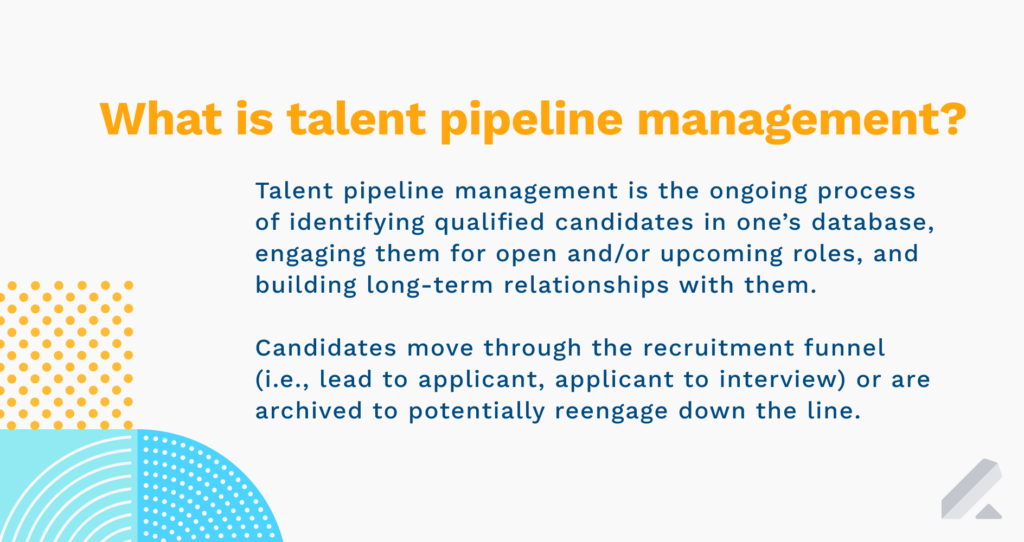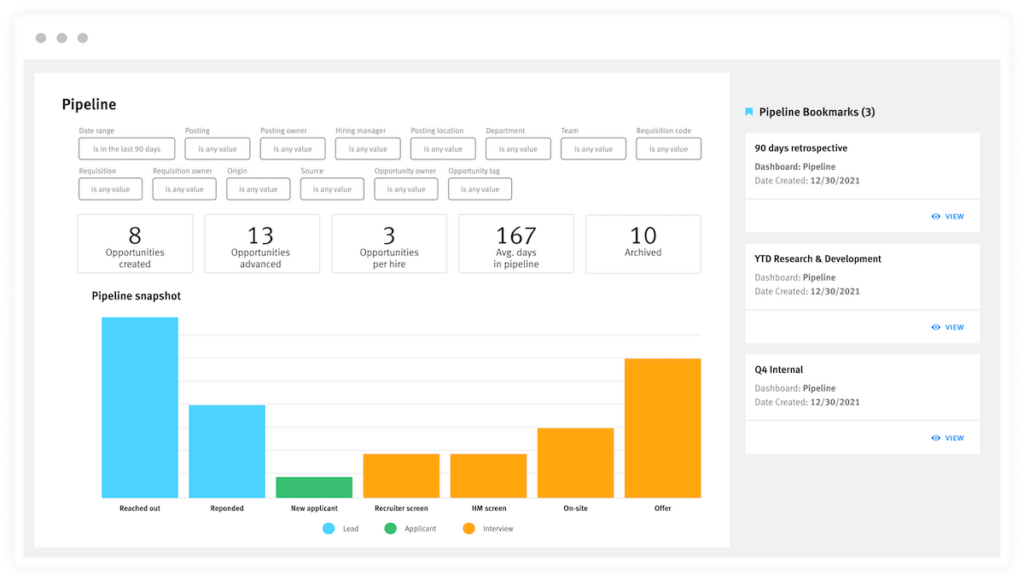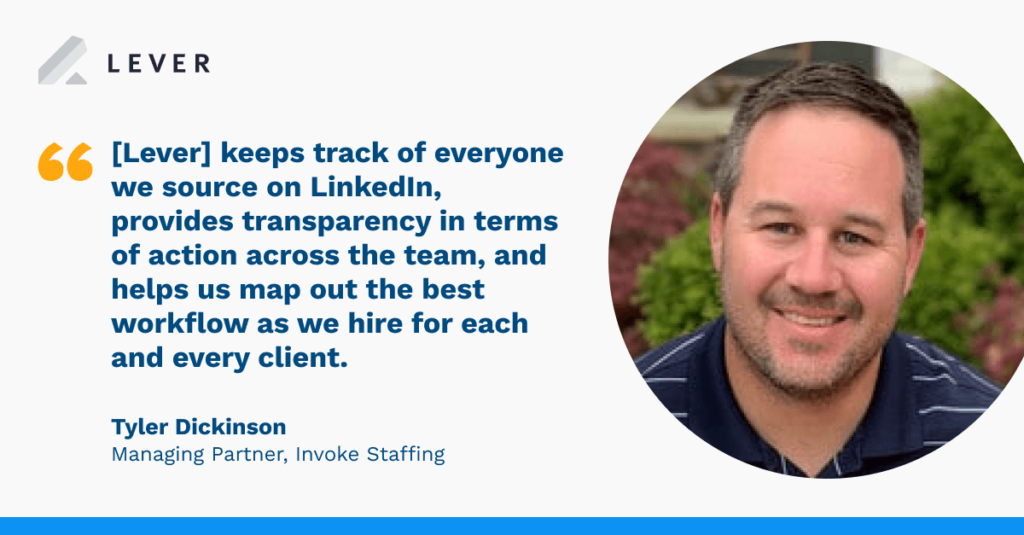Building a talent pipeline is one thing. Making the most of said pipeline is another. Both tasks require a concerted focus from everyone in your talent organization.
But, creating a talent pipeline solely for the sake of developing a database of qualified candidates and failing to employ any proactive recruitment measures (e.g., personalized outreach through intelligent nurture emails) will only lead to a ‘stale’ talent pool.
It’ll also lead to an inefficient hiring process, since recruiters aren’t building relationships with ‘good-fit’ external candidates or evaluating internal talent.
With a take-charge approach to engaging job candidates — and a centralized solution in which you can source, nurture, analyze, and rediscover prospects with ease — though, you can craft a more effective talent pipeline management program.
One that leads to a greater ability to fill roles with high-quality hires and greater productivity.

3 ingredients for better talent pipeline management
The best talent strategies all constructed with these three critical building blocks.
1) A dedicated candidate relationship management (CRM) mindset with LeverCRM
First things first: You must adopt a CRM approach across your TA team.
Recruiting is no longer about having one-time, transactional relationships with talent, Rather, it’s about developing and maintaining long-term relationships with candidates.
Consider Lever customer Talend:
- The cloud-data business built a pretty strong talent pipeline management program. Its TA team was able to find high-quality candidates across social media, job boards, and other online channels. And yet, hiring these newly sourced prospects was taking far too long.
- So, it revamped its recruiting process — and embraced a CRM mentality. Specifically, it recognized archived candidates — notably, silver-medalists (i.e., those who made it to the final interview stage, but weren’t made an offer) were worth reconsidering for open requisitions.
- By focusing its recruiting efforts mostly on this subset of potential candidates, Talend was able to speed up its time to fill by 46% compared to hiring newly sourced talent. That equated to a hiring conversion rate that was four business weeks faster than hiring net-new prospects.
Your team’s CRM strategy will certainly look different than those of other orgs across different industries and of varying company sizes.
The point is leveraging your talent pipeline based on your distinct business model and hiring needs/quotas and ‘playing the long game’ with nurturing and engaging candidates in your database will help you become far more productive — and realize far better hiring results.

2) Tech that helps you build an intelligent, unified talent pipeline
No CRM strategy is complete (or can be executed effectively) without the right tech.
Spreadsheets aren’t the answer. Legacy ATS aren’t the answer. So … what is?
Only a complete talent acquisition suite with essential ATS functionality and advanced CRM capabilities can enable you to establish a CRM approach, streamline your daily work, and enhance your ability to engage, manage, and convert your talent pipeline.
From lead, to outreach, to interview, LeverTRM users can see the entire CRM lifecycle. From lead, to outreach, to interview, LeverTRM users can see the entire CRM lifecycle.
They’re able to do this by leveraging our innovative CRM capabilities that help them engage, advance, and archive active and passive candidates alike:
- Fast Resume Review: Screening can be done much quicker with this functionality. Skipping, advancing, and archiving talent is simplified. Meanwhile, prospects spend less time sitting in the ‘queue,’ waiting to hear from recruiters, which leads to a higher-quality CX.
- Nurture Recommendations: Many LeverTRM users know they have lots of first-rate candidates in their talent pool. The issue is identifying them efficiently to nurture them for open and upcoming roles. Our solution swiftly resurfaces qualified talent for TA specialists based on different criteria (e.g., origin of source, feedback scores, archive reasons).
- Intelligent Pipeline: Manually ‘moving’ individuals from one recruiting stage to the next is arduous. It’s also unnecessary — at least for LeverTRM customers. Our intelligent pipeline provides automated stage progression (i.e., lead to applicant, applicant to interview) and, in turn, an at-a-glance view that shows recruiters, TA pros, and hiring managers alike where candidates are in their funnel.
Standalone recruiting tools certainly offer capabilities like this. But the top talent pipeline management strategies are built around a unified TA suite that offers them all in one place.

3) A coordinated, ongoing effort to optimize your talent-pipeline strategy
Your colleagues in HR work hand in hand to improve new hires’ onboarding experience, enhance employee engagement across the business, and build a strong employer brand.
While they tackle these tasks, you and your TA team must optimize your pipeline management.
Each team member must understand the specific duties and KPIs/metrics for which they’re accountable (e.g., time to hire, net-new talent attraction, interview/candidate experience). What’s more, they need to know how they can continually elevate their engagement and conversion efforts to boost performance.
Core responsibilities that, when handled well — and with a centralized TA solution — lead to a stronger pipeline management approach (i.e., a well-oiled recruiting machine) include:
- Evaluating the efficacy of sourcing channels: Want to continually improve your quality of hire? You need to know where the best candidates come from. This activity requires TA tech that helps you discover the origin of your ‘strongest’ employees are sourced.
- Analyzing nurture-campaign effectiveness: With each TA specialist ‘owning’ optimization of nurtures to their respective segments (by role and/or location), they can share what modifications helped them increase talent engagement with the rest of their team.
- Adjusting tags assigned to archived talent: A big part of data ‘clean-up’ is addressing issues with how you store and sort through candidate data. With an ATS + CRM like Lever, you can designate specific, searchable tags for every prospect in your system. This will enable you to rediscover top talent in a matter of minutes (if not seconds), not hours or days, and reengage them as needed.
Whatever task(s) you and your talent team are charged with handling, it’s vital you all work from the same single-source-of-truth candidate database to ensure you continually refine your recruiting efforts and unearth top-tier talent you can move through your pipeline.
You can’t improve your talent pipeline management without the right TA tech. Download our ATS Buyer’s Guide to learn what your organization should look for in recruiting software.



